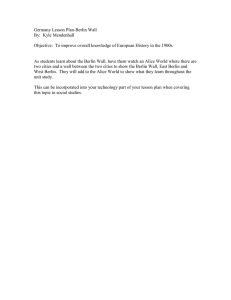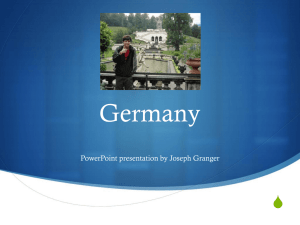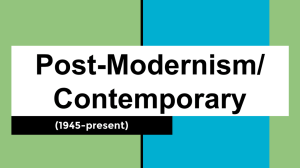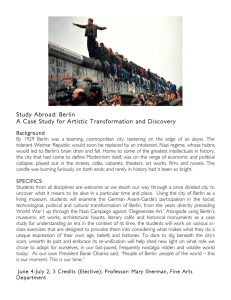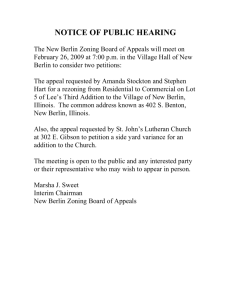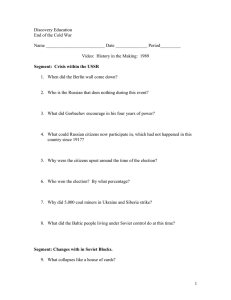to the PowerPoint presentation
advertisement
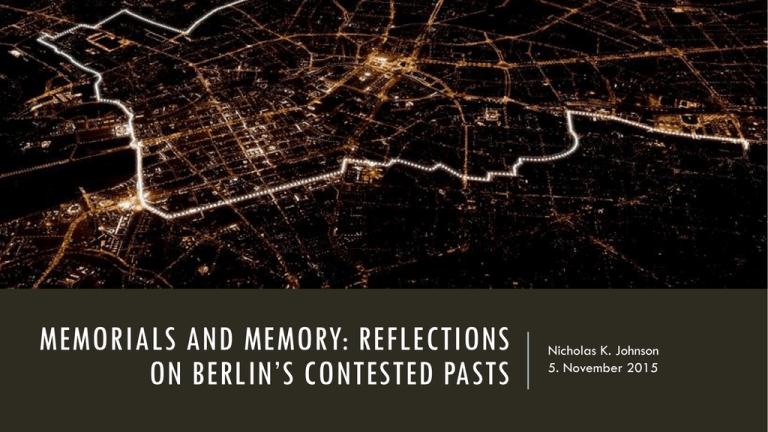
MEMORIALS AND MEMORY: REFLECTIONS ON BERLIN’S CONTESTED PASTS Nicholas K. Johnson 5. November 2015 BACKGROUND: THE FREE UNIVERSITY’S PUBLIC HISTORY PROGRAM Freie Universität Berlin Founded in 1948; West Berlin’s main university Only German Public History Program, began in 2007 Averages 20 students per year; collaboration with the Center for Contemporary History in Potsdam (ZZF) My exchange was funded by a joint IU/FU Graduate Student Exchange Fellowship SA PRISON PAPESTRASSE MEMORIAL First discovered in mid-1990s Permanent Exhibition 2013 Only historic site in Berlin with unequivocal traces of Nazi seizure of power still visible Part of the early concentration camp system in Berlin; operated from 1933 until 1934 Torture cellar for political prisoners SA PRISON PAPESTRASSE 1933-1934 The SA now part of Berlin’s police force during this period Mass arrests soon after the Nazi seizure of power; the Papestrasse was an initial detainment site Most of those targeted were communists, trade unionists, social democrats, and prominent Jews At least 10 prisoners confirmed murdered in the cellar; likely number much higher GRAFFITI FROM 1933 Swastika and “F.J.K. III.B” which is an SA unit designation TRACES OF VIOLENCE EXHIBIT Temporary exhibit fully researched, designed, and built by Public History MA students from the Free University, October 2014-March 2015 Focused on the lasting effects of torture and unlawful imprisonment of 6 former inmates and their families Oral History interviews with family members; archival research Budget of around 1200 EUR EXHIBIT INSTALLATION, MARCH 2015 AUDIENCE AND TRANSLATION Translation an important issue in German exhibits, especially in Berlin Often a weak point of historical exhibits due to translators’ lack of familiarity with history terminology Over half of tourists now non-German; non-German audience often lacks prior knowledge of both German history and language Issues encountered: Passive voice, double entendres, style. Literal vs. “spiritual” translation? PLACES OF REMEMBRANCE: BAYERISCHER VIERTEL “Berlin’s Most Unsettling Memorial” – NYRB, 2013 “Decentralized” memorial designed by artists Renata Stih and Frieder Schnock in 1991 80 signs depicting anti-Jewish laws placed throughout neighborhood Photo courtesy Nick Sacco, June 2015 EXAMPLES DECENTRALIZED MEMORIALS: STOLPERSTEINE DECENTRALIZED MEMORIALS AND PUBLIC HISTORY Renata Stih on “Places of Remembrance”: “[W]e want it to be uncomfortable. We don’t want people to say, ‘We didn’t know.’ ” NYRB, 15 June 2013 Historian Joseph Pearson on Stumbling Stones: “…the inscription is insufficient to conjure a person. It is the emptiness, void, lack of information, the maw of the forgotten, which gives the monuments their power and lifts them from the banality of a statistic.” The Needle Berlin, August 2010 Is there room for decentralized memorials in the American public history landscape? BERLIN WALL MEMORIAL, BERNAUER STRASSE A: The Wall and the “Death Strip B: The City’s Destruction C: The Construction of the Wall D: It happened at the Wall. BERLIN WALL WALKING TOUR • Exhibit is mostly outdoors including weatherproof video and audio stations • Very large for a memorial within a city • Visitor’s center marred by simplistic, triumphalist narrative with fall of the wall “solving” German history FURTHER EXAMPLES CONFLICTED MEMORIES OF BERLIN WALL Bernauer Strasse Memorial from (government) historians’ point of view. Sober, remembers the dead, offers a reconciliatory narrative. Majority of tourists first encounter the wall at the East Side Gallery, a preserved section of the wall coated in street art and graffiti. East Side Gallery simultaneously a touristic cliché and subversive public art “My God, Help Me to Survive This Deadly Love,” Dmitri Vrubel, 1990 (Brezhnev and Honecker) THE COLD WAR AND FALL OF THE WALL IN GERMAN PUBLIC HISTORY Increasingly present in exhibits, film, and television Generation born in late 1980s now entering the field and “historicizing” this period Questions both official triumphalist narrative and “Ostalgie (Nostalgia for the East)” Focus on everyday life in East Germany Hottest trend at the moment Photo courtesy Nick Sacco, June 2015 BERLIN-HOHENSCHÖNHAUSEN MEMORIAL Former Stasi (East German Secret Police) Prison Complex EYEWITNESS-LED TOURS Most guided tours of BerlinHohenschönhausen are conducted by former inmates Our tour guide, Hans-Jochen Scheidler, was imprisoned in 1968 for distributing leaflets. His imprisonment completely destroyed his career aspirations. Focused on his own experiences including arrest, interrogation, solitary confinement, psychological torture, and total surveillance. EYEWITNESS-LED TOURS THE STASI POST-1989 Stasi Records Agency (BStU): Federal body tasked with maintaining and investigating Stasi records Stasi Archive; people allowed to look up their own files Names and photographs of informants, Stasi agents, etc. all publicly mentioned in exhibit text “This is your future” - Scheidler GERMANY IN 2015: “THE WALL IN THE HEAD” Economically weak former East compared to former West Rising anti-EU, anti-immigrant rightwing (PEGIDA, AfD) in former East Germany Many former East Germans see reunification as a “raw deal” Lack of critical historical attention on pre-1989 West Germany currently a big blind spot in public memory CODA: REBUILDING THE KAISER’S PALACE THE PALACE OF THE REPUBLIC East Germany’s Parliament Building Huge symbolic importance for East Germans Contaminated with asbestos, closed in 1990. Cleared of asbestos by 2003. Demolished in 2008 to make room for…? GDR Palace of the Republic, 1976 THE BERLIN CITY PALACE Berlin residence of Kaiser Wilhelm and the Hohenzollern family Heavily damaged during WWII, demolished by the GDR due to its status as a symbol of “Prussian imperialism” New site (so-called “Humboldt Forum”) Reconstructed façade Ethnographic collection Berlin City Palace, 1920s CONTROVERSY Most former East Germans opposed the reconstruction of the city palace on various grounds Others, particularly urban planners, see the palace as anachronistic Proponents argue demolition a triumph over modernist architectural styles favored by both “soulless” communist and neo-liberal ideas One theory sees reconstruction as a result of an “inability to grieve" the loss of Germany's old “glory” as an Empire. Is this really more “palatable” past than that represented by the Palace of the Republic? SUMMARY Internationalization of Public History Challenges of interpreting German history Practical challenges: audience, translation, digital history QUESTIONS?
